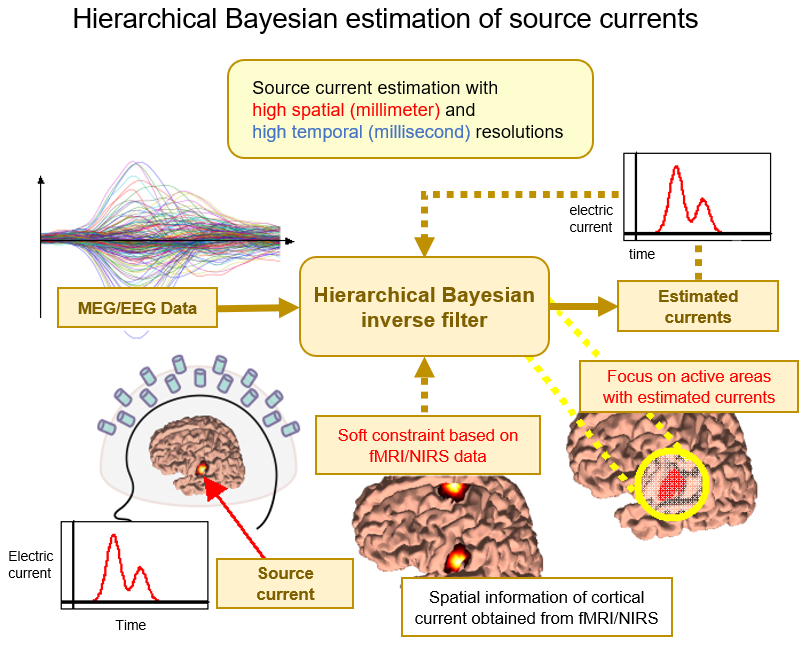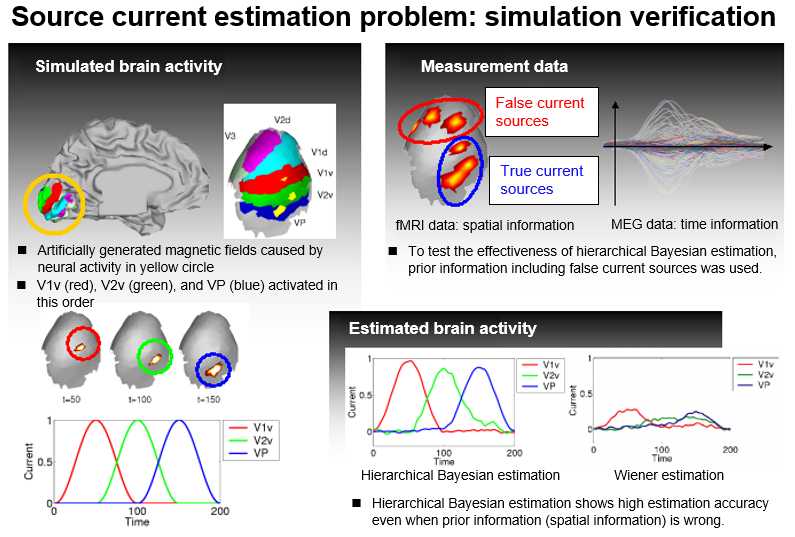Cortical current estimation with high spatial and temporal resolutions by integrating multimodal brain measurements
Revealing brain dynamics requires measurement of brain activities with high spatial and temporal resolutions on the millimeter and millisecond orders. However, no current measurement method satisfies this requirement.
Magnetoencephalography (MEG) and electroencephalography (EEG) have high temporal resolutions on the order of milliseconds. However, they measure the magnetic and electric fields outside the head, so it is difficult to know the exact locations of the sources.
To find the locations, we need to solve the “source current estimation problem,” where we estimate source currents (cause) from measurement data (effect). This problem is known to be an inverse problem in which source currents cannot be uniquely determined solely from the data, even if there is no noise.
To solve this problem, we need to use prior information on the source currents. Conventionally, qualitative properties of currents have been used as the prior information, such as smallness and smoothness of the currents. However, the source currents estimated by these approaches tend to have low spatial resolution.
In 2004, we developed a hierarchical Bayesian current estimation method (hVB, Sato et al., 2004). Using fMRIs as the prior information on the current variance, it estimates source currents with high spatial and temporal resolutions by a variational Bayesian method.
Other methods also incorporate fMRI as the prior information (Liu et al. 1998; Dale et al. 2000). However, they suffer from inaccurate fMRI.
These methods assume that fMRI provides completely accurate information on the distribution of the current variance. However, this assumption is not always true owing to the differences in sensitivity between fMRI and MEG/EEG, errors in statistical processing, and differences in experimental paradigms between fMRI and MEG.
However, hVB solves this problem by adjusting the confidence in fMRI information based on MEG/EEG data. As a result, even if fMRI has inaccurate information, hVB provides reasonable source currents by emphasizing MEG/EEG data.
Another feature of hVB is that its estimated currents tend to be spatially sparse, which is compatible with the localization theory of brain activity.
The reliability and usefulness of hVB have been confirmed by various simulation and real experiments (visual, somatosensory, auditory, and motor). We developed a MATLAB toolbox, Variational Bayesian Multimodal EncephaloGraphy (VBMEG), to perform hVB and released it on the web. Please test hVB yourself by using VBMEG.
References
-
- Sato, M. et al., 2004. Hierarchical Bayesian estimation for MEG inverse problem. NeuroImage, 23(3), pp.806–26.
- Dale, A.M. et al., 2000. Dynamic statistical parametric mapping: combining fMRI and MEG for high-resolution imaging of cortical activity. Neuron, 26(1), pp.55–67.
- Liu, A.K., Belliveau, J.W. & Dale, A.M., 1998. Spatiotemporal imaging of human brain activity using functional MRI constrained magnetoencephalography data: Monte Carlo simulations. Proceedings of the National Academy of Sciences of the United States of America, 95(15), pp.8945–50.
- Rosa, M.J., Daunizeau, J. & Friston, K.J., 2010. EEG-fMRI Integration: A Critical Review of Biophysical Modeling and Data Analysis Approarches. Journal of Integrative Neuroscience, 09(04), pp.453–476.
- Materials related to VBMEG


